Spring bulbs A to Z
It’s time to plant Spring Bulbs
| A | is for Autumn Don’t miss out! Get busy planting bulbs in autumn, so come spring, you’ll have beautiful flowers to enjoy outdoors, and some more to pick. |
| B | is for Bulb food Bulb food contains the right balance of nutrients to support healthy growth and flowering. At planting, mix thoroughly into the soil so that bulbs are not in direct contact with fertiliser. If leaving bulbs in the ground, feed again after flowering to support strong healthy flowering next spring. Don’t use concentrated powdered fertilisers in pots. Instead, add a little slow-release fertiliser or use a bulb planting mix, which has fertiliser already added. |
| C | is for Containers Bulbs thrive in containers. Plant generously so that the pots look full. A single layer of bulbs can be planted so that they are almost touching. In a deep pot, planting in staggered layers extends the flowering season, the deepest bulbs blooming slightly later. Always plant in fresh potting mix. |
| D | is for Drainage Drainage is essential for spring flowering bulbs. If your soil is heavy or wet in winter, plant in pots filled with well-drained planting mix. |
| E | is for Erythronium Erythronium, or ‘dog’s tooth violet’, named for the shape of its corm is one of the few spring flowering bulbs suitable for a shady woodland spot. Quaint nodding flowers resemble miniature lilies in subtle shades of cream and yellow with pretty mottled leaves. Plant into a cool, moist position in rich soil. These bulbs will die if they’re left to dry out. |
| F | is for Freesias Plant a pot of freesia bulbs every few weeks through autumn and winter, and you’ll have flowers to bring indoors from June until Christmas. Place the pots in a cool shady position until shoots appear, then move them to a bright sunny spot for flowering. The old fashioned and double varieties have the most fragrance. |
| G | is for Glads Most of us know gladioli as tall summer flowers, but there are also spring flowering gladioli to plant in autumn. The graceful Gladiolus nana hybrids are smaller than their bold summer flowering cousins. Because they flower when it’s cooler, they’re less likely to attract thrips. |
| H | is for Hyacinth Hyacinths in pots make a charming table piece where their colour and perfume can be enjoyed up close. |
| I | is for Iris Dutch irises come in many beautiful shades of blue, white, and yellow. Whether you plant in pots or garden soil, these bulbs must have perfect drainage and full sun. |
| J | is for Jonquils Sweet smelling, old-fashioned jonquils are easy to grow, lovely for picking and ideal for naturalising under deciduous trees. |
| K | is for Kids Growing bulbs in pots is a fun activity for children. Try growing a hyacinth or crocus bulb in a glass vase so they can watch the roots grow too. |
| L | is for Lift and divide As bulbs multiply and the clumps become crowded, flowers become fewer and smaller. When you notice this happening, it’s time to lift, divide and replant. Dig them up in late summer after the foliage has died down. Discard damaged or soft bulbs and store in trays or paper bags in a dry airy place until you are ready to plant. |
| M | is for Mass planting Make a statement and create maximum spring impact by mass planting bulbs in bold blocks of colour. |
| N | is for Narcissi The Narcissi genus includes jonquils, paperwhites and hundreds of different daffodil varieties. Planting a range of early, mid and late flowering varieties means your spring display will last longer. Among the earliest to flower are the very fragrant ‘Erlicheer’, ‘Paperwhite’ and traditional trumpet daffodils. |
| O | is for Onions Onions are bulbs too. They’re grown from seed sown in autumn or winter. |
| P | is for Patience If you want your daffodils to flower year after year, don’t be tempted to cut or tie bulb foliage after flowering has finished. Let the leaves die down naturally. Nutrients flow from the fading foliage back to the bulb, essential for next year’s flowering. Daffodils in lawns should not be mown until about six weeks after flowering. |
| Q | is for Quality When buying bulbs, look for large firm bulbs and avoid those that feel soft or have blemishes and bruises. |
| R | is for Ranunculus Ranunculus (and anemones) are first to arrive in store, in late summer. If planting early, keep them cool and moist with a 5cm layer of mulch. For best results plant fresh tubers each year and soak in water for a few hours prior to planting. Plant tubers with their claws facing downwards. |
| S | is for Sunshine Most flowering bulbs need sun, but you can plant daffodils and bluebells under deciduous trees, which drop their leaves and let the sun through while the bulbs are growing. |
| T | is for Tulips In a warm climate, get the best from your tulip bulbs by keeping them in the fridge for six to eight weeks before planting. |
| U | is for Upside-down With some bulbs it can be hard to tell which way is up, but fortunately, most bulbs will still grow, even if you plant them upside-down. |
| V | is for Violas Ideal bulb companions and available in a huge choice of colours, violas look pretty while you wait for the bulb flowers to appear and continue flowering alongside the bulbs in spring. Plant seedlings in autumn. |
| W | is for Wilderness For a no-fuss natural look, plant bulbs under deciduous trees, in paddocks or along fences and driveways. In well-drained soil they’ll multiply to give you more and more flowers. To avoid overcrowding, which reduces flowering, lift and divide every four or five years. Bulbs for naturalising in a warm climate include daffodils, snowflakes, bluebells, and freesias. In cold climates daffodils, crocus, bluebells, snowdrops and tulips are suitable for naturalising. |
| X | marks the spot! If you want to lift your bulbs for replanting next autumn, mark their spot so that you can find them once the foliage dies down. Add a name label so you’ll know which variety is which at replanting time. |
| Y | is for Yellow Yellow is the colour of happiness. Fill your garden with golden daffodils – they’ll make you smile every year when they pop up in late winter. |
| Z | is for Zephyranthes Also known as autumn crocus, or rain flower, this bulbous plant has attractive grassy foliage and starry flowers. In the wild they pop up after autumn rain. |
Tip: For best flowering, keep tulip and hyacinth bulbs cool while their roots grow. Place in cool shade, or try sinking pots onto the ground until the shoots appear, but be sure to apply slug bait!
A Potful of Hyacinths
- Choose a clean pot with holes for drainage. A 20cm diameter pot or bowl will hold four to six bulbs.
- Fill with bulb planting mix and plant bulbs so that they are almost touching.
- Water thoroughly and place the pot in a cold shady place outdoors, or in the fridge. Keep the potting mix moist.
- Once flower shoots appear (after about six weeks), move the pot to a sunny spot for flowering.
- Once open, flowers last longer if moved away from direct sun.

1-Apr-2015
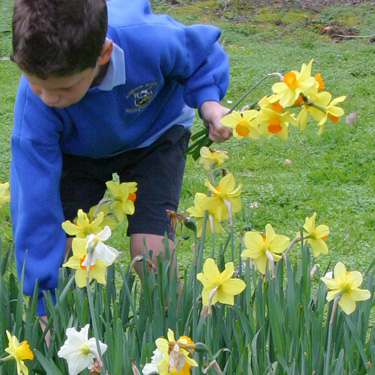
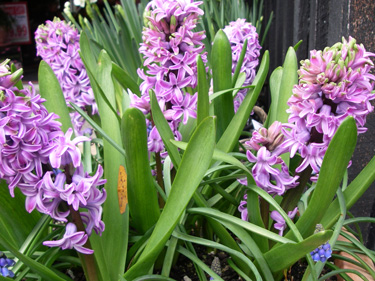
Hyacinths
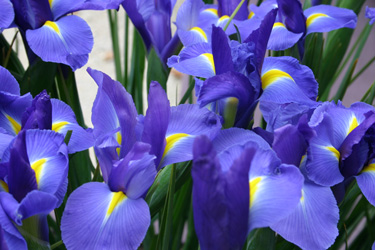
Dutch iris
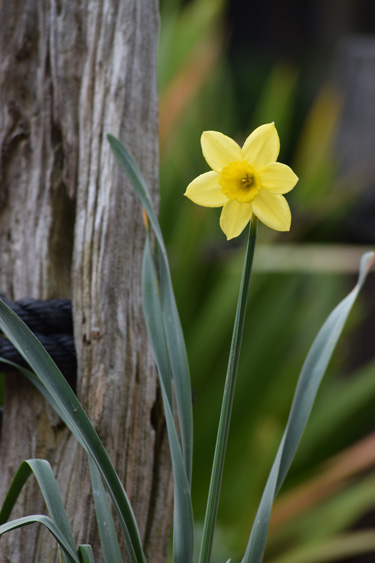
Narcissus or daffodil
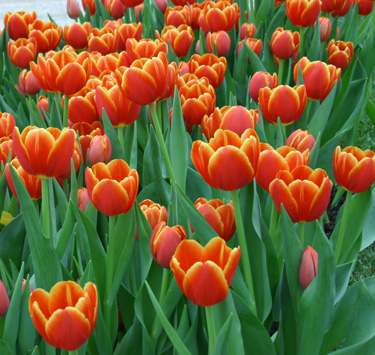
Tulips

